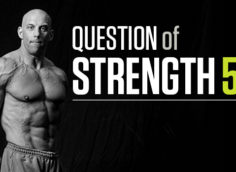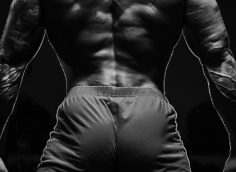You Need a Bigger Glass
Getting seriously strong takes some time, but there's an upside to strength that I learned from Brett Jones:
"Absolute strength is the glass. Everything else is the liquid inside the glass. The bigger the glass, the more of everything else you can do."
What this means is that the stronger you are, the more athletic qualities you can add to what you can do. In that spirit, here are the "secrets" to strength:
I wouldn't have mentioned this years ago because when I grew up we used to play on monkey bars and challenge ourselves to pull-up tests. We grew up with strong grips. In fact, I'd never even heard of straps until after I'd been Olympic lifting for a few months.
But that was then. Weak grips seem to be epidemic nowadays. Luckily, the hands are amazing feats of engineering. Your brain uses a lot of its energy and wiring to make the hands work better. So, we can learn to engage our brains more by focusing on our grip.
Take the Grip Test

First, test your grip. Everyone should be able to hang from the pull-up bar for at least thirty seconds. Some of us will discover just from this test how lousy our grip might be and how jacked up our shoulder girdle has become.
But that's a simplified test. The actual test is this:
Hang from the bar for thirty seconds. When the timer rings, do a pull-up. If you can do that, you're not too bad.
But let's push it a little. Without letting go, drop back down and hang for another thirty and do a second pull-up. For the true crazies, let's see who can do 10 of these 30-second hang pull-ups.
Few can. Gripping is the weak point for most trainees. To improve it, train with thick bars. My first thick bar deadlift told me how far I needed to go, despite all my hours on the monkey bars.
There are lots of bonuses from doing deadlifts, curls, and rows with thick bars, including learning how to achieve perfect positions in lifting. But what I came away with was this: The thick bar was a simple trick to build superior strength.
If you don't have a thick bar, use adaptors. Or, go cheap and split a PVC pipe of appropriate width and length and slip it over a standard barbell. A two-inch grip is difficult and the three-inch is brutal.
I hate the name "core," but you know what I mean when I say it. Getting strong in the area between your legs and head is more than just doing some crunches for your six pack. Most of the time, you should train core and grip strength together.

The suitcase carry is my stock answer to all things core related. Find a reasonably heavy dumbbell or kettlebell. Just one. Pick it up and walk away. And that's it.
Men should use at least 80 pounds and women can usually use around 50. Today, you'll notice your grip strength. Tomorrow, you'll notice your obliques.
Now let's go back to grip strength. The upside of testing it with the pull-up is that you also were testing your core. I have dip rings in my backyard and I get a fabulous workout just playing on the rings. Monkey bars provide the same grip/core workout as does rope climbing and most gymnastics work.
I work with an All-Star catcher and he credits early gymnastics training and racing on BMX bicycles for his success in baseball. Both disciplines train the grip and core without actually training the grip and core. That's the key here: Get the work in on these two areas and enjoy the general improvement throughout your system.
Add some suitcase walks, increase your pull-ups, and you'll develop your grip and core strength.

I had the opportunity to speak with Dick Smith years ago. Smith was part of the great revolution of lifting in the early 1960's. He was there for the "pink pill" [the steroid Dianabol], but he also was the leader in applying isometric work to strength training, specifically the Olympic lifts.
Isometrics work. Yes, they were overhyped for a long time, but pushing as hard as you can against something that won't move is a way to train your nervous system to light up. Smith emphasized three points in adopting isometrics:
- No overtraining!
- Motivation!
- Flexibility!
In this case, flexibility referred to a quality of the mind. He wanted you to think when it came to training.
Dick still laments the loss of isometric work in the USA. Most people just didn't get it. Why? Isometrics didn't make you feel tired. So, people would start to add in more work and soon it was a few sets here and a few sets there until they were doing entirely too much.
The problem, according to Dick, was that most people just float through in training their weak points. "With isometrics, you focus there." Sure, that kind of workout doesn't feel like much, but it puts a huge load on recovery ability.
Dick warned people to train hard in the racks, but nobody listened to how simple isometrics could be and we tossed it to the side.
Isometrics do require some equipment. They also require some honesty about where your weak points are. But, when used for about a six-week period, nothing can cure a strength deficit better.
In my case, my weak point was when the bar was at 34 inches in the front squat. I attacked it with six dedicated weeks of isometrics. I just loaded the bar up with everything I had so I couldn't move it and did one isometric set for 12 seconds (give or take), twice a week for a few weeks.
I never missed a clean and jerk recovery for the rest of my active career.
Isometrics work. Do them.

If I could make everybody start lifting from scratch, I'd insist that we start with fixed weight bars.
Or, like we had in our college weight room, a total lack of small plates. When we wanted to go up in load, we often had only two 25-pound plates we could add. And let me tell you, fifty-pound increases challenge your strength!
When I first lifted, most people had the 110-pound weight set you bought from Sears. We'd work up to 110 for one ugly single press. Over the span of the next few weeks, we'd work purely on our strength as the reps climbed from one to five or so. Then, the reps would climb up from that and visible muscle would appear as we moved into the hypertrophy range.
That taught me a lot about strength and it's reflected in my "Rule of Ten." It refers to doing approximately ten working reps in a strength workout. The classic heavy workouts follow this rule:
- 5 sets of 2
- 3 sets of 3
- 2 sets of 5
It's hard to go heavy for more than ten reps.
Take a few months a year of simply trying to get stronger: fewer reps and more load. Then, with your newfound strength, crank up the reps but don't drop back too far on the load. That's the ticket to both strength and size.

I believe in adding load. But, keep this in mind: load can be anything. Sure, barbells, dumbbells and kettlebells are the most obvious examples, but chains, bands, and even hand pressure are all load.
The issue most lifters have is that they'll sacrifice anything and everything else (health, fitness, and life) to increase load. The problem is, only beginners can really increase load each workout or each week; the rest of us have to coax it along.
So, strength training lives in a dichotomous world. On one hand, increasing load is the proof, the measurement, and the reward for training intelligently. On the other hand, increasing load leads to missing lifts.
I know this: Every injury I've ever sustained on the lifting platform was from a missed lift.
So, load is king, but it's a tyrant. After the initial spurt of progress, most of us need to cycle or periodize our training somehow to keep progress moving ahead. After a few months of following a percentage program, I find the shift to something like Escalating Density Training to be rejuvenating.
To get stronger, add more weight. But, have a plan.





